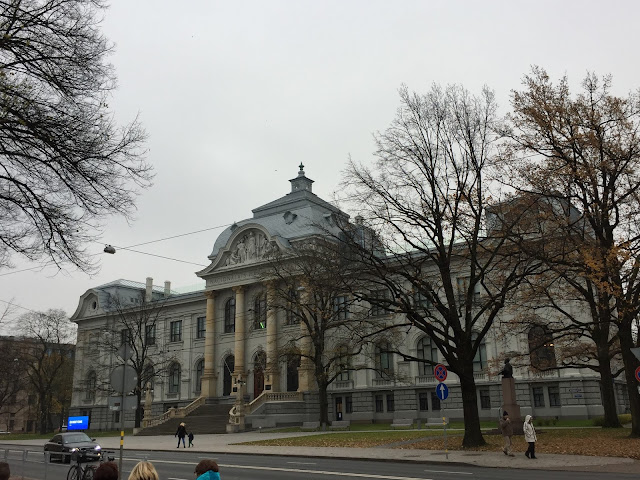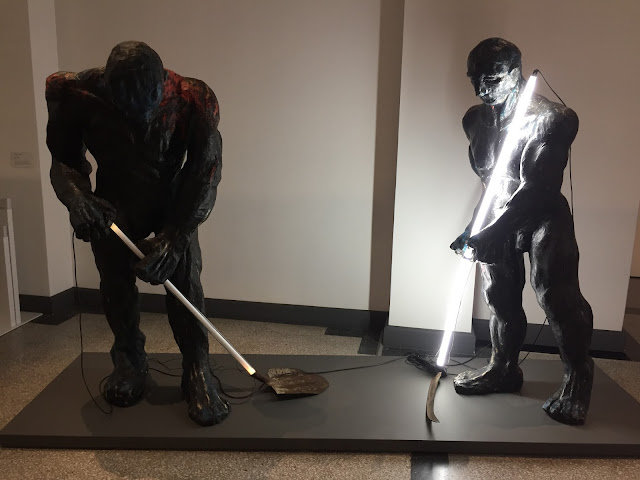196. Regional Travel #4.3 - Latvian National Museum of Art
The Latvian National Museum of Art is my favorite art museum in Riga. It's housed in an impressive Baroque and Classicism style building, which was the first purpose-built structure (in 1905) intended to be used as a museum in the Baltic countries. The museum underwent extensive renovations recently and was reopened to the public at the end of 2015.
The museum's collection includes over 40,000 works, primarily from Latvian and Russian artists. The exhibits on the first, second, and third floors are arranged chronologically throughout the galleries, and grouped according to the major periods in Latvian art history (which closely mirror the major political events in the region during the 20th century): 1780-1890, 1840-1900, 1900-1915, 1915-1940, 1930-1940, 1945-1985, and 1985-2000. I enjoyed learning about the linkages between Latvia and the art scenes in Europe and Russia, the prominent role that Latvian artists had in commenting on (and sometimes shaping) political events, the Latvian modernists active in Russia in the 1920s and 30s, and the return of Neo-Expressionism and abstract art at the collapse of the Soviet Union.
The top floor of the museum contains a small attic-like room that showcased a temporary exhibition on jewelry designed by artists better known for their paintings (Dali, Picasso, Koons, Braque, and Hirst, for example). The pieces were all on loan from a private collector, and were acquired by her before anyone else realized they were worth collecting. I'm sure that most of the 113 pieces of jewelry (by 82 artists) in this exhibit are priceless in today's fine art jewelry market. I had read about this show in the Baltic Air magazine during my flight from St. Petersburg to Riga and was happy to visit it the following day.
I also enjoyed an exhibit on the works of Fridrihs Milts on the third floor. He was born in Riga in 1906 and worked here until his late 30s. In 1944, he moved to Germany as a refugee, and then immigrated to New York in 1951 and began working as a building supervisor in Hell's Kitchen. He remained an active artist until his death in 1993. The paintings in this show were primarily from his New York period, and I believe that most of them have not been seen before in his native country.
The Great Exhibition Hall in the basement houses a variety of contemporary pieces in the special exhiibition "Title Doesn't Matter". All the art (including paintings, sculptures, and video installations) were presented without any interpretation or signage. Outside of any context, some of the pieces worked for me, and others did not. The basement also included an extensive storage space for paintings. It was interesting to compare the similarities in art storage technique between the Riga Art Museum and the Staraya Derevnya Restoration and Storage Center in St. Petersburg.

Janis Osis (1926-1991) - Rowing Race at a Latvian Fishermen's Festival (1958)
Vilnis Zabers (1963-1994) - Yellow Analysis (1993):
Andris Breze (1958- ) - Masters of the Land (1988):
The entrance hall:
Johann Leberecht Eggink (1784-1867) - Prince Vladimir Chooses a Religion in 988 (1822):
Alexander Heubel (1813-1847) - Self-Portrait (1846):
Michael Alexander Michelson (1815-1899) - Landscape with River (1880):
Artist's jewelry, from Picasso to Koons. Diane Venet's collection:
Paintings by Fridrihs Milts:
Emils Melderis (1889-1979) - Portrait of Pavils Rozitis (1921)
Teodors Zalkalns (1876-1972) - Portrait of Modest Mussorgsky (1928):
Konrads Ubans (1893-1981) - Portrait of Edvarts Virza (1917):
Painting storage in the basement:
Contemporary art in the Great Exhibition Hall ("Title Doesn't Matter"):
The museum's collection includes over 40,000 works, primarily from Latvian and Russian artists. The exhibits on the first, second, and third floors are arranged chronologically throughout the galleries, and grouped according to the major periods in Latvian art history (which closely mirror the major political events in the region during the 20th century): 1780-1890, 1840-1900, 1900-1915, 1915-1940, 1930-1940, 1945-1985, and 1985-2000. I enjoyed learning about the linkages between Latvia and the art scenes in Europe and Russia, the prominent role that Latvian artists had in commenting on (and sometimes shaping) political events, the Latvian modernists active in Russia in the 1920s and 30s, and the return of Neo-Expressionism and abstract art at the collapse of the Soviet Union.
The top floor of the museum contains a small attic-like room that showcased a temporary exhibition on jewelry designed by artists better known for their paintings (Dali, Picasso, Koons, Braque, and Hirst, for example). The pieces were all on loan from a private collector, and were acquired by her before anyone else realized they were worth collecting. I'm sure that most of the 113 pieces of jewelry (by 82 artists) in this exhibit are priceless in today's fine art jewelry market. I had read about this show in the Baltic Air magazine during my flight from St. Petersburg to Riga and was happy to visit it the following day.
I also enjoyed an exhibit on the works of Fridrihs Milts on the third floor. He was born in Riga in 1906 and worked here until his late 30s. In 1944, he moved to Germany as a refugee, and then immigrated to New York in 1951 and began working as a building supervisor in Hell's Kitchen. He remained an active artist until his death in 1993. The paintings in this show were primarily from his New York period, and I believe that most of them have not been seen before in his native country.
The Great Exhibition Hall in the basement houses a variety of contemporary pieces in the special exhiibition "Title Doesn't Matter". All the art (including paintings, sculptures, and video installations) were presented without any interpretation or signage. Outside of any context, some of the pieces worked for me, and others did not. The basement also included an extensive storage space for paintings. It was interesting to compare the similarities in art storage technique between the Riga Art Museum and the Staraya Derevnya Restoration and Storage Center in St. Petersburg.

Janis Osis (1926-1991) - Rowing Race at a Latvian Fishermen's Festival (1958)
Ojars Abols (1922-1983) - The Proletariat Carrying the Sun. Latvian Artists in 1919 (1968):
Maija Tabaka (1939) - Wedding at Rundale (1974):
Biruta Delle (1944- ) - Alone (1988):
Vilnis Zabers (1963-1994) - Yellow Analysis (1993):
Andris Breze (1958- ) - Masters of the Land (1988):
The entrance hall:
Johann Leberecht Eggink (1784-1867) - Prince Vladimir Chooses a Religion in 988 (1822):
Alexander Heubel (1813-1847) - Self-Portrait (1846):
Michael Alexander Michelson (1815-1899) - Landscape with River (1880):
Johann Walter (1869-1932) - The Market in Jelgava (1897):
Artist's jewelry, from Picasso to Koons. Diane Venet's collection:
Paintings by Fridrihs Milts:
Emils Melderis (1889-1979) - Portrait of Pavils Rozitis (1921)
Teodors Zalkalns (1876-1972) - Portrait of Modest Mussorgsky (1928):
Konrads Ubans (1893-1981) - Portrait of Edvarts Virza (1917):
Painting storage in the basement:
Contemporary art in the Great Exhibition Hall ("Title Doesn't Matter"):












































































Comments
Post a Comment